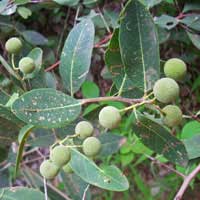 Full List of Fruits
Full List of Fruits  Aizen fruit
Aizen fruitAizen Fruit
Scientific name - Boscia senegalensis
Aizen or Boscia senegalensis is acknowledged as a potential way out to hunger and a buffer against famine in the Sahel region due to the assortment of useful products it yields. It gives out a lot of produces for consumption, household needs, medicinal and agricultural uses. Aizen fruit is nutrient-rich, pulpy gem which ripens on a palm tree. Containing vitamins B1, B2, B5, ascorbic acid, minerals, iron, potassium, phosphorus and calcium, the maroon scales should be peeled off before eating. The fruit is consumed as it is or can be made as juice, jam or ice-cream as well.
![]() Nutritional Value of Aizen fruit
Nutritional Value of Aizen fruit
| Calories | 265 | |
| % Daily Value* | ||
| Total Fat | 10.5 g | 16 % |
| Total Carbohydrate | 11 g | 4 % |
| Protein | 3.0 g | 6 % |
When most of the crops are just being planted, the fruits of Aizen are ready at the beginning of the rainy season and a very little other foods will be available to you. It can be consumed either raw or cooked. In general, raw fruits contain a sweet pulp, juices can also be extracted. Aizen fruit is high in vitamins and minerals, and is a good source of dietary fiber. It is also rich in antioxidants and phenolic compounds, which have been shown to have anti-inflammatory and anti-cancer properties.
Aizen fruit can be eaten raw, but is also often used in jams, jellies, juices, and other recipes. It can also be used to make sorbets and other frozen desserts. The fruit is commonly dried and used as a garnish or snack.Aizen fruit is a great source of nutrients and has a variety of health benefits. It is known to reduce cholesterol, improve digestion, and boost the immune system. It has also been linked to improving metabolism and helping to regulate blood sugar levels.
![]() Health Benefits of Aizen fruit
Health Benefits of Aizen fruit
Reduce malnutrition and mortality.
Boosts Immunity
Promotes Heart Health.
Improves Digestion.
Prevents Cancer.
Boosts Brain Function.
![]() Method of propagation in Aizen fruit
Method of propagation in Aizen fruit
Aizen fruit is propagated through the hardwood cutting method. Hardwood cuttings are made from mature stems of the Aizen tree in late winter or early spring. The stems should be cut 10-15 cm long with a sharp, sterile tool. The bottom of the stem should be cut at an angle, and then the stem should be treated with a rooting hormone. The cuttings should be inserted into a well-draining potting mix, such as a mix of peat moss and vermiculite. The pot should be kept in a warm, humid area and should be watered regularly. After a few months, the cuttings should have rooted and can then be transplanted into their permanent location.
Aizen fruit, also known as the "Lingonberry," is a species of deciduous shrub native to northern and eastern Europe, northern Asia, and North America. It belongs to the genus Vaccinium, and has been cultivated as a food crop for centuries. The plant grows in dense thickets and prefers acidic, moist soils. The Aizen fruit has been cultivated for centuries in the Nordic countries, and was introduced to North America in the mid-19th century. It has since become a popular addition to home gardens, and is grown commercially in parts of Canada and the United States. The plant is also widely used in traditional medicine, as its leaves and roots are believed to have medicinal properties.
In recent years, the Aizen fruit has become a popular ingredient in health drinks and dietary supplements. The berries are rich in vitamins, minerals, and antioxidants, making them a great source of nutrition. They are also high in dietary fiber, which can help promote digestive health. Additionally, the fruit has been found to contain anti-inflammatory properties, making it beneficial for those suffering from chronic inflammation.The Aizen fruit is also a popular ingredient in cosmetics, as it is believed to have skin-nourishing properties.


















